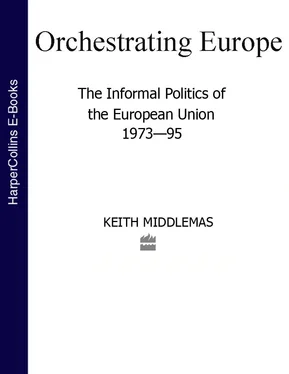On balance, the major achievement of the first fifteen years of the CAP was the removal of arbitrary quantitative controls that had characterized intra-European trade since the late 1920s and early 1930s. It also erected an external regime that created an EEC preference zone (although this could also have occurred without common policies). Finally, it attempted to implement a single system and level of protection throughout the Community. All these factors generated a sizeable increase in intra-European trade, but at considerable cost. Nobody in the post-War period questioned whether agriculture should be protected and all economic protection has to be paid for in some way. The ‘consumer pays’ principle chosen for the CAP was, in its nature, a regressive tax on food that augmented the cost of living. The effect of this was compounded by the increasingly high price levels that repressed domestic consumption whilst stimulating output. As production swung towards structural surpluses, so the costs of intervention, buying and storage increased and ate into the funds intended for structural renewal. The solution of disposing (or dumping) the surpluses on the world market also served to undermine relations with external trading partners who had already been disconcerted by being squeezed out of EEC markets and who now had to sustain the impact that the sporadic sale of large commodity stocks had on the fragile levels of world prices.
The removal of tariffs and quotas ahead of their original schedules was, as we have seen above, a milestone in the histories of both the EEC and EFTA. Since EFTA, too, had in 1961 and again in 1963 decided to accelerate its own timetable, within the blocs of the Six and the Seven tariffs had vanished completely by 1969. 19Yet, as it was understood at the time, the dismantling of tariffs and quotas was a necessary but not sufficient condition for ensuring free competition:
* Both organizations allowed the retention of some quotas for cultural and similar reasons.
* Both faced customs formalities for the restitution and reimposition of indirect taxes (and EFTA also had to contend with certificates of origin).
* Both saw individual administrative and technical obligations assume a more restrictive character.
* Both had to confront the effects of methods of levying taxes on business, incentives for investment and the granting of subsidies – which all acted to distort competition.
* Both still had to tackle the problem of cartels and restrictive practices.
EFTA ducked many of these issues by only investigating complaints made by governments (and there were not many), whereas the Commission dedicated itself to eliminating these sources of trade distortion in principle. Yet the EEC only really started to address these problems at the end of the 1960s and even then made very slow progress. Even discounting the new protectionist measures introduced after the 1973 oil crisis, the Commission’s own judgment in 1981 is revealing: ‘The customs union, the implementation of which is intended to ensure the internal market, is proving to be increasingly inadequate for the achievement of this aim.’
As tariffs and quotas were dismantled, so the impact of non-tariff barriers became more apparent. Some argue that their incidence became more prevalent as business turned to new protective devices to compensate for the loss of traditional forms of protection. However there have been no historical studies to substantiate or deny this. The Treaty of Rome stressed the need for a general system to protect competition from distortions (art.3(f)) and developed the areas of policy, the competences of the Commission and Council, and the rules and procedures in articles 85ff. Articles 85 and 86 declared that agreements between enterprises, together with dominant market positions capable of distorting trade, were incompatible with the Common Market. Furthermore, they prohibited dumping and state subsidies (though the latter came with a long list of exceptions). Lastly, state monopolies (art.37) should be reshaped, and fiscal as well as legal dispositions should be adjusted.
All these provisions remained sketchy, however, and it was the task of the EEC institutions and Commissioner, Hans von der Groeben, to flesh them out. Given the different interests and perceptions in this field, the problem was formidable, but it was by no means the only one. Competition policy was ambiguous as a concept, and the possible negative sides of a stringent competition policy were much resented. On the other hand, it could be articulated in more positive terms by suggesting that what Europe needed was more, rather than less, concentration in the interests of maximizing efficiency. 20
On the question of state monopolies, the Commission could, after the first stage, recommend measures for reshaping them, which it did in several cases, usually by proposing gradual modifications which increased imports, eliminated the disparity of margins and adjusted to market conditions. There is insufficient evidence available to judge the impact of these rulings but in some cases, such as tobacco, it was shown that imports from other member states increased considerably. Yet given the facts that the Commission tried to work with, rather than against, member states, and that these had often and publicly voiced firm opposition, analysts generally agree that the policy of the Commission in this field was rather cautious. Moreover, celebrated successes such as tobacco need to be counterbalanced by equally significant setbacks: the reintroduction of a French petroleum monopoly represented a de facto break of the standstill agreement of art.37, to the effect that no further state monopolies should be introduced.
State subsidies also presented a thorny and difficult problem, the more so since subsidies were poorly and ambiguously defined in the Treaty. Generally, subsidies were deemed incompatible with the Common Market since they could distort trade between member countries. Yet industrial or regional policies were seen as necessary adjuncts to a mixed economy – and this implied financial aids. Thus it was necessary to distinguish between ‘adjustment’ and ‘unfair government aid’ and the Commission had the power to scrutinize existing state subsidies. Should they distort trade, it could ask that they be abolished or amended. It could also rule that the subsidy was compatible or necessary. Similarily, new ‘other’ subsidies could be introduced with a qualified majority vote of the Council.
The Commission became active in this field early in 1959 and demanded information on the financial aids in use among the member states. Following this, it had some success in persuading governments to amend and/or end subsidies – as in the case of German synthetic rubber, or on the more rapid depreciation allowances for French producers buying French equipment – together with similar practices in Italy. Moreover, considerable progress was made in the early 1960s in completing the inventory of existing aids and agreeing on information procedures. Yet as late as 1974, so Cairncross and Giersch argue, the praxis of state aid was still not transparent and, on the whole, EC policy failed adequately to tackle the problems of state aid. Matters grew worse after the Luxembourg compromise, when the Commission’s attitude can best be described as pragmatic awareness of the difficulty of successfully challenging determined member governments. Difficulties with financing subsidies from the EEC’s own funds contributed, though this problem diminished over time. Not surprisingly, the level of government subsidies showed little inclination to decline. What is more, the Community had still failed to define uniform criteria and conditions for judging the admissibility of aid.
The Treaty of Rome empowered the Commission to submit proposals on restrictive business practices and dominant positions which were able to distort competition – i.e., cartels and imperfect competition. It did so in 1960, and in 1962 the Council adopted Regulation 17, which was called by Swann/McLachlan ‘an obscure legal document’. It reaffirmed the prohibition on restrictive business practices (art. 85 (1)) and ruled that they could be dissolved. It also subjected the firms concerned to a fine. First of all, though, it provided a notification of such agreements and a procedure to determine the action taken. This succeeded in attracting the notification of more than 35,000 restrictive agreements, most in the hope of securing acceptance and many involving fairly innocuous trading practices. By the end of 1962, however, Commission officials had isolated almost five hundred as constituting serious impediments to international trade. 21Even so, many of the ‘traditional’ cartels had not registered at all.
Читать дальше









![Brian Thompson - A Monkey Among Crocodiles - The Life, Loves and Lawsuits of Mrs Georgina Weldon – a disastrous Victorian [Text only]](/books/704922/brian-thompson-a-monkey-among-crocodiles-the-life-thumb.webp)


